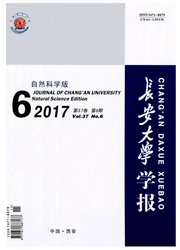

 中文摘要:
中文摘要:
针对西安市主城区外围地铁线路多处于地裂缝研究空白区的实际问题,采用人工地震勘探与钻探方法研究查找地裂缝,为地铁线路穿越地裂缝的设防提供基础资料,其中人工地震勘探方法主要是从地下数百米深度范围内对地裂缝异常进行定性判断,划定异常区;钻探方法则通过分析近地表数十米深度内地层的连续性来定量判断是否存在地裂缝。研究结果表明:在西安东郊浐河、灞河一级阶地,可将厚度较大、连续性较好的中更新统砂卵石层作为判断是否存在地裂缝的标志层,该层埋藏深度一般为30~60m,地层错断8~10m,钻探深度一般70~80m可满足要求;对于西安西南郊皂河、沣河一级阶地,地层结构复杂,沉积韵律差,缺少具有一定厚度且连续分布的标志层;采用大吨位震源车的人工地震勘探技术与勘探异常部位钻探验证相结合的方法,可有效识别地裂缝异常。
 英文摘要:
英文摘要:
Ground fissures distribution near Xi'an metro lines is unknown outside the main urban areas. In order to provide basic data for metro line passing through ground fissures, drilling and seismic exploration methods were employed to study and find out the ground fissures. Seismic exploration method can give qualitative judgment of ground fissure anomalies in the range of hundreds of meters under ground, and de- limit anomalous area. While drilling method may quantitatively determine the existence of ground fissures through the analysis of stratum continuity in the range of tens of meters under surface. The results show that in the east suburb, first terrace area of Chanhe River and Babe River, an uninterrupted thick Middle Pleistocene gravel stratum, buried at the depth of 30-60 m, with faulted stratum 8-10 m, can be referred to symbolic layer. The depth of borehole set at 70-80 m can meet the requirements for locating ground fis- sures. In the southwest, suburb first terrace area of Zaohe River and Fenghe River, however, because stra- ta have structure complexity and poor sedimentary rhythm, and is lack of a thick and continuous symbolic layer. In order to overcome the problem, seismic exploration with large tonnage vibrator vehicle technology should be adopted. For the seismic explorative anomaly, some boreholes should be arranged to identify ground fissure effectively. 1 tab, 7 figs, 15 refs.
 同期刊论文项目
同期刊论文项目
 同项目期刊论文
同项目期刊论文
 期刊信息
期刊信息
